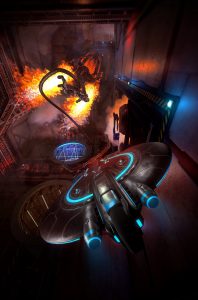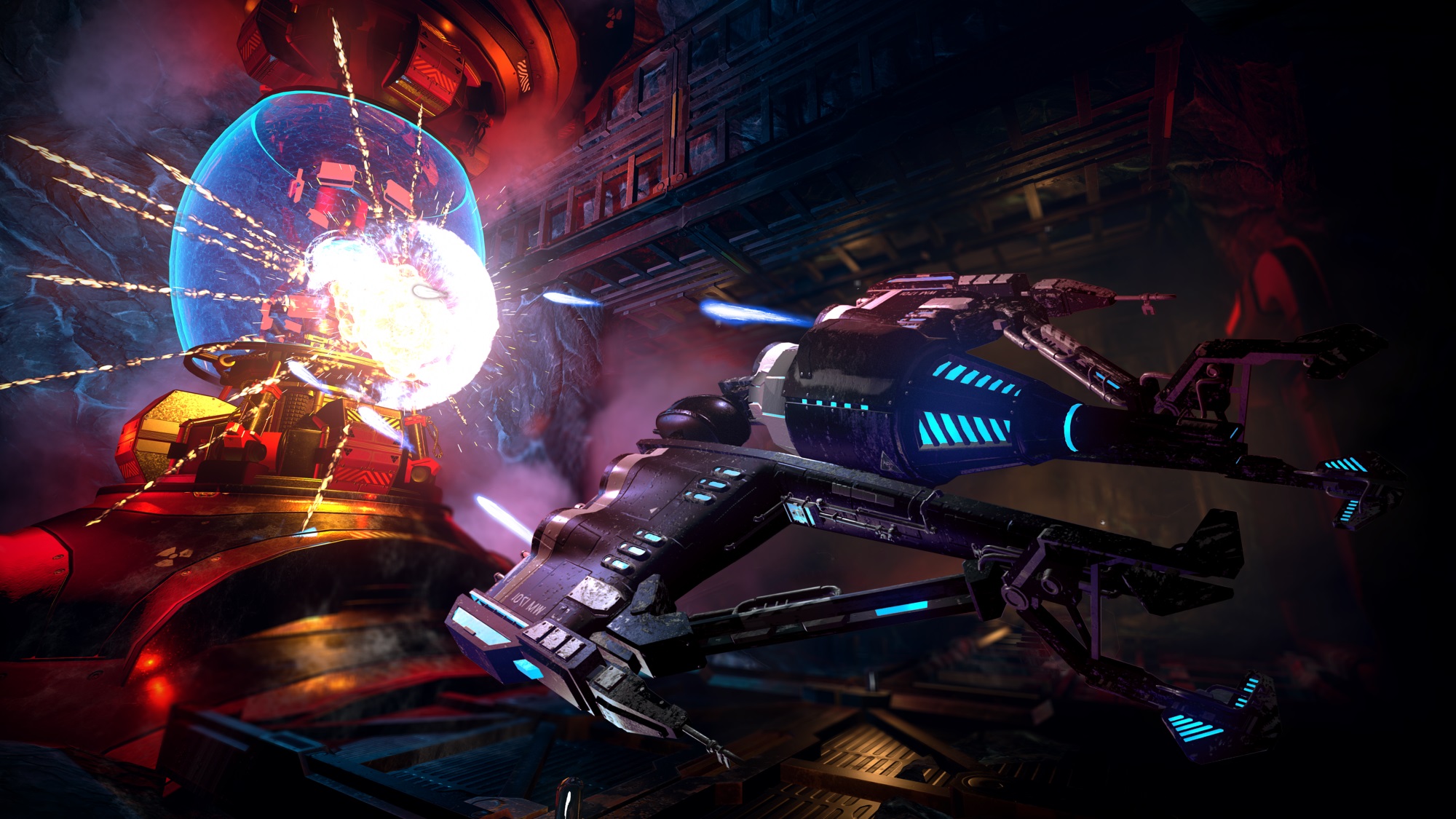
Fallout 76 wasn’t the only Interplay throwback at E3 2018: Descent, one of the games that defined the six degrees of freedom genre, is no longer underground. That is, the former title has changed because Interplay’s embraced the game and given the developers full support.
Descendent Studios team is hard at work on launch, Little Orbit CEO Matt Scott met with us to discuss what’s been going on in the past several years of development. Nostalgia aside, I went in expecting the worst: long-abandoned IP, Kickstarted game, indie team, extended public development, and fairly quiet presence on social media. However, I came out very pleased. While the game may not be an MMORPG, what I saw and heard makes me think that this may be the space experience I’ve been waiting for.
Taking off the rose-colored viewport
I want to be very upfront about my bias before going in. Descent was the first PC game I ever owned. I never got to play multiplayer because figuring out how to set up a LAN was beyond my elementary-school skill set. I never finished the game, but my brother and friends would take turns playing for hours before we’d get tired of losing and build spaceships out of cardboard boxes.
That’s it. Concussive missiles, Vulcan Canons, and six-degrees of freedom in tight space-mining shafts with color-coded corridors are burned into brain, but I can’t tell you much more than that without Wikipedia. I had childhood love of the game, so what I expected from what I’d seen and heard was just a space game with the Descendent name being launched well before it was ready.
And that’s not at all what I played.
Even Scott admitted the game isn’t banking on nostalgia alone. With Little Planet stepping in and having recently acquired GamersFirst, and with Interplay granting the team a perennial license, the focus isn’t on just making a new game targetting old players. It’s about introducing a new generation to Descent that appeals to the modern gamer while feeding vets some nostalgia on the side.
That means physical copies of the game in stores. It means launching on multiple consoles and setting up cross-platform to PC. It means online multiplayer, both PvP and PvE campaigns. It means customizable ships (both in looks and RPG-esque tech trees), free multiplayer DLC to keep the playerbase together, singleplayer DLC content for monetization, and oh-em-gee player housing. I don’t mean to overhype here, but it’s the kind of stuff that, if this were a persistent world instead of a lobby game, would make Descent seem like a rival for Star Citizen or Elite Dangerous.
When Scott let me pick up the controller, there was a mix of nostalgia with that new game feel. I played the original on a mouse and keyboard, but the Xbox controller (my least favorite) felt quite natural. The ships handled like a streamlined version of what I recall of Star Citizen’s E3 2014 demo. Turns out it’s one of many things influenced directly by player feedback thanks the game’s public development.
Friendly fire is on in the single-player game though, so make sure you don’t accidentally stand too close to a wall and shoot yourself. No worries if you do in most situations, as shields can be replenished from mob drops, but losing your health is permanent.
Without going into too many details, the story is that earth ran out of resources, so people mine them from a nearby asteroid belt. However, the asteroid belt is owned by megacorporations, who have turned the belts into arenas where pilots compete to get the most resources: The Underground Games. It paints a vague picture of the world not only for the single player mission, but multiplayer as well.
 The original 1990s game was single ship and a few levels, but shortly into the modern game, I’m given a “hack” mission to steal a new type of ship. The current game has four ship types (I was told about a DPS/healer/tank trinity), 20 ship models, and tons of customization, at least in multiplayer. While you can switch up skins, wings, ship noses, and more, the basic silhouette remains.
The original 1990s game was single ship and a few levels, but shortly into the modern game, I’m given a “hack” mission to steal a new type of ship. The current game has four ship types (I was told about a DPS/healer/tank trinity), 20 ship models, and tons of customization, at least in multiplayer. While you can switch up skins, wings, ship noses, and more, the basic silhouette remains.
Hacking in Descent just means sitting on the right piece of terrain while the loading button changes to the right color. It’s easy to understand, oddly modern for this genre, but keeps a vague Descent flavor.
The level layout is where most of the fond memories are held. No, they’re not copies of old levels, but they feel like an extension of what I played as a kid: twisting, turning, almost claustrophobic environments with bullet hell-ish situations. The enemy designs look familiar, my old friend the Vulcan Canon made an appearance, but the environment had destructible areas that hid cool secrets, bringing some of the series’ exploration into the modern age. Flares help you see in the dark, but also can alert enemies to your presence. While I remember mining being part of the story, it never hit me as much in the original game as it hit me with this new Descent.
Color-coded keycards are back, and they’re just as handy as I remembered. As simple as it sounds, corridors are color coded. If you don’t get the blue keycard, you can’t get far into the blue corridor. If you do find the blue keycard, finding the blue corridor is a snap if you’re not colorblind. Post-E3 I asked about accessibility for colorblind players and was told that the team will be “adding iconography and arrows to the walls to help colorblind players. This includes symbols for Reactor Cores, Security Gates, Ship Garages, Nanofactories, and more.”
At the end of the level, I had what Scott felt is the definitive “wow” moment that hopefully solidifies the new Descent experience. After I finished exploring this mining station, picking up security cards, and hacking into a new ship and through some security defenses, a giant mining ship tunneled up through the level to ambush me. Visually it’s cool, and again, helps lock in the idea of space mining, but how the fight plays out is something we’ll have to wait for.
That “waiting for the story” isn’t a coincidence either. At the moment, the only thing holding the game back is the need to finish the singleplayer campaign. There are currently 16 missions, and the team is focusing on finishing the last of them.

Multiplayer and the future
One thing that’s been interesting about the game’s development is that it started on Steam and moved to Brightlocker, more of a closed community compared to Steam, so that made getting input a bit different. The team felt that the intimacy with the Brightlocker players was nice, when it had time, but as the team fell into crowdfunding hell, it was unable to keep up. That’s why Little Orbit was called in.
Little Orbit also helped ensure that the multiplayer could be robust, not just in terms of game design, but by having good server support with a company that’s got experience in that department. While the game will eventually have eight kinds of multiplayer modes, it’s launching with only four to ensure no one’s in an endless queue. The plan is to include various kinds of death matches (solo and team-based) and a group mode to mine (or protector a miner) from enemies as you collect resources because, again, this is a game about space mining. You’ll also have the option to go through the singleplayer game with up to three other players to beat a beefed-up version of your adventures.
As monetization is focusing on DLC, Scott decided to give me a vague outline of the company’s future plans, from release to the end of 2019. I wasn’t allowed to take any pictures, but I was told that “Chapter 2” will add eight more singleplayer missions. Spring 2018 will be a fun, free cosmetic update. Housing will eventually come holiday 2019.
Now, housing is something Scott didn’t want to talk about much, but the basic idea is that it will be an extended lobby area where you can hang out with friends between matches. Your friends can visit your home, but to get your own, you’ll need to buy the (seemingly final) singleplayer DLC. Expect more info coming on July 10th.
Scott also mentioned that in order ensure that more people can be exposed to Descent, the game has to hit consoles. Crossplatform play can help with this between consoles and PC (Sony still won’t allow a direct connection between the Xbox and PlayStation families), but as we PC fans know, nothing can beat a mouse and keyboard. That’s why the team is looking at giving people using controllers some shooting/pickup assistance, to help keep them from falling behind their mouse and keyboard friends. It’s cool, since I seem to meet more console players these days, but I lamented Sony’s decision. Scott mentioned that they’re “hoping other companies will put enough pressure on Sony” to allow the team to connect console players to each other. Plus, Nintendo will allow crossplay with Microsoft and PC, which feels huge.
With that, I had to ask Scott if the team had looked into the Nintendo Switch. When I asked Scott about it, there was some hesitance, followed by, “I won’t say at this point…. More announcements coming soon.” I got excited for a moment, and I feel like that excitement reflected back in him for a moment. Scott went on to add that the Switch has been a bit slow on their network, so that’s the team’s concern. We’ll see what happens.
Speaking of new venues, I asked about VR, an aspect the game picked up on early but didn’t seem like much more than a simple add-on. Scott confirmed that VR is still being worked on but is being looked at due to the controversy of preventing motion sickness. The reasons behind why people get sick are being argued, but one idea is to have a co-op VR mode where at least one person isn’t controlling the ship and acts as, say, a gunner. It could be something Starfox-esque even.
I came into my interview expecting little but left with what I feel like is a lot. It may not be an MMO, but with the huge development time of Star Citizen and the intensity of the Elite experience, Descent may offer the accessible space shooter experience some of us want but have been struggling to find in the online sphere.















